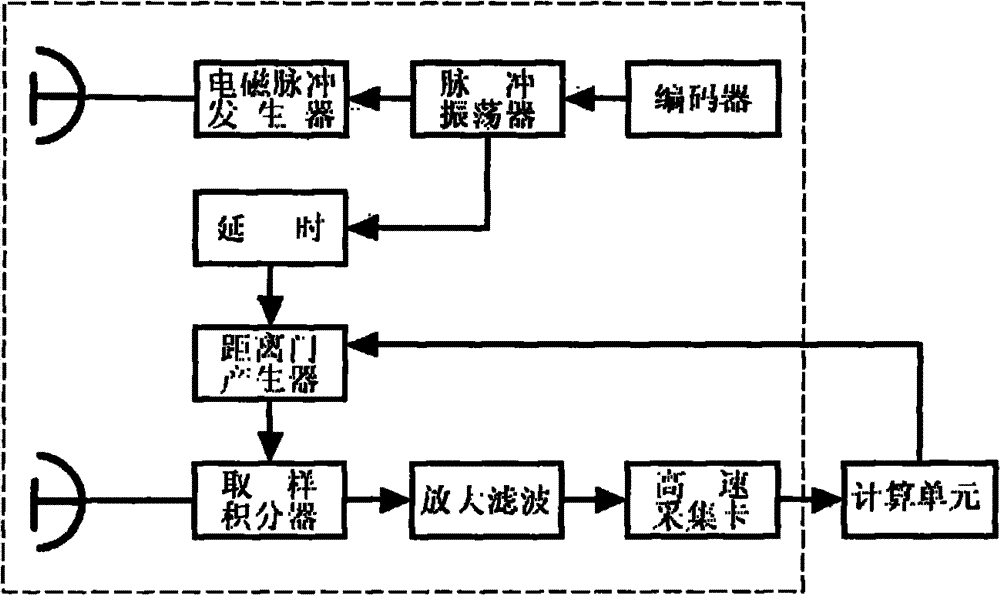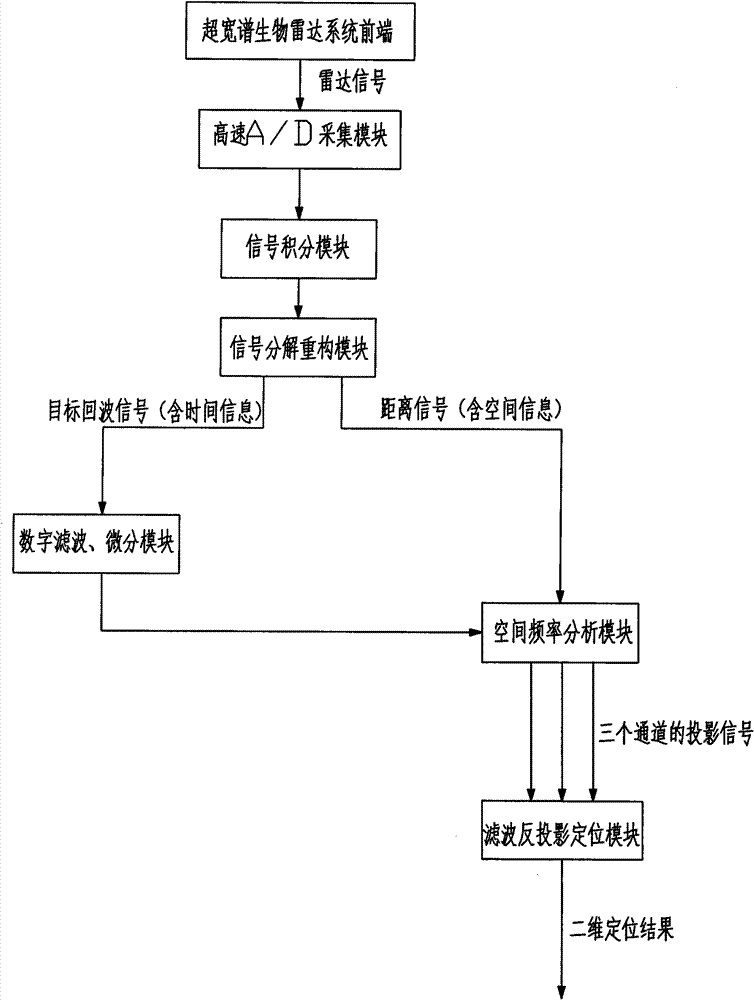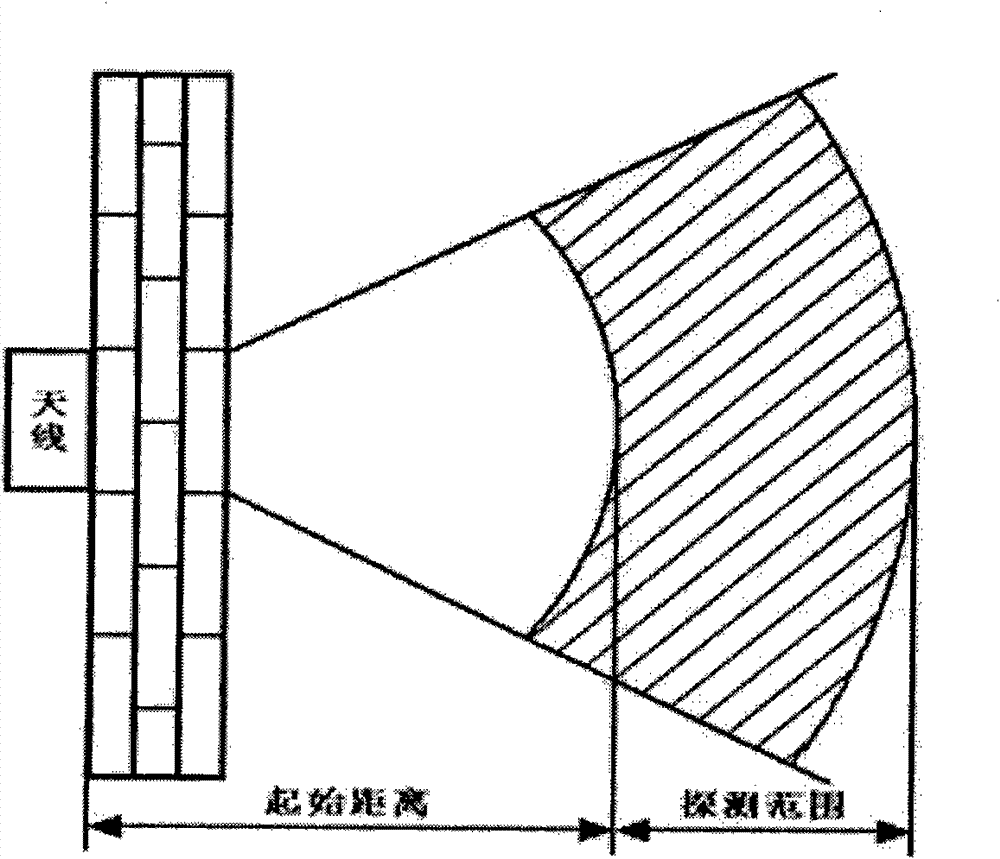Multichannel multi-human body target two-dimensional positioning method based on UWB (Ultra Wide Band) radar type life detector
A life detector and human body target technology, which is applied in the field of two-dimensional positioning of multiple human targets, and can solve the problems of identification and two-dimensional positioning of multiple stationary human targets that have not yet been solved.
- Summary
- Abstract
- Description
- Claims
- Application Information
AI Technical Summary
Problems solved by technology
Method used
Image
Examples
Embodiment 1
[0041] This embodiment takes a certain channel in the multi-channel as an example to illustrate, figure 1 It is the principle block diagram of the single-channel ultra-wide spectrum radar life detector system. First, the pulse oscillator generates a pulse signal, which triggers the electromagnetic pulse generator to generate narrow pulses, which are radiated through the transmitting antenna. The reflected signal is sent to the sampling integrator through the receiving antenna. The signal generated by the pulse oscillator passes through the delay circuit to generate a distance gate, and the received signal is selected. The signal passes through the sampling integrator circuit, and the weak signal is accumulated after thousands of pulses. It is detected, amplified and filtered, and then sampled by the high-speed acquisition card and sent to the calculation unit. The calculation unit analyzes and identifies the collected signals, and finally calculates the target distance.
[00...
Embodiment 2
[0050] In this embodiment, one channel in the multi-channel is taken as an example to illustrate the weak signal enhancement method of a static target.
[0051] To realize the recognition of stationary human targets, the weak life signals of stationary human bodies should be enhanced first. In this embodiment, according to the characteristics of the UWB radar echo signal, the weak biomedical signal processing method is used to process the signal after high-speed sampling and enhance the useful signal to improve the signal-to-noise ratio and realize the basic recognition of human targets .
[0052] Use 8-point 4-point integration method to integrate the signal in the distance; then break up the signal for decomposition and reconstruction, and synthesize the target echo signal and distance signal; digitally filter and digitally differentiate the target echo signal to achieve Enhancement of weak useful signals.
[0053] 2.1 Integration of signals
[0054] The sampling rate of ...
Embodiment 3
[0089] In this embodiment, a certain channel in the multi-channel is taken as an example to illustrate the one-dimensional distance distinction method and the spatial frequency analysis method:
[0090] After the weak signal enhancement of the static target is completed, it is necessary to distinguish the distance of the human target. Because the range signal is an ultra-low frequency signal that reflects the distance information of the target, the present embodiment constructs a joint distribution function of space and frequency, and adopts the joint analysis method of space frequency (reformed Time-frequency analysis) analyzes the distance signal, describes the energy density and intensity of the signal at different distances and frequencies, and then gives the distance information of each human target.
[0091]Time-frequency analysis represents the change of the signal spectrum on the time axis. When the time variable is changed into a distance variable, the time-frequency ...
PUM
 Login to View More
Login to View More Abstract
Description
Claims
Application Information
 Login to View More
Login to View More - R&D
- Intellectual Property
- Life Sciences
- Materials
- Tech Scout
- Unparalleled Data Quality
- Higher Quality Content
- 60% Fewer Hallucinations
Browse by: Latest US Patents, China's latest patents, Technical Efficacy Thesaurus, Application Domain, Technology Topic, Popular Technical Reports.
© 2025 PatSnap. All rights reserved.Legal|Privacy policy|Modern Slavery Act Transparency Statement|Sitemap|About US| Contact US: help@patsnap.com



